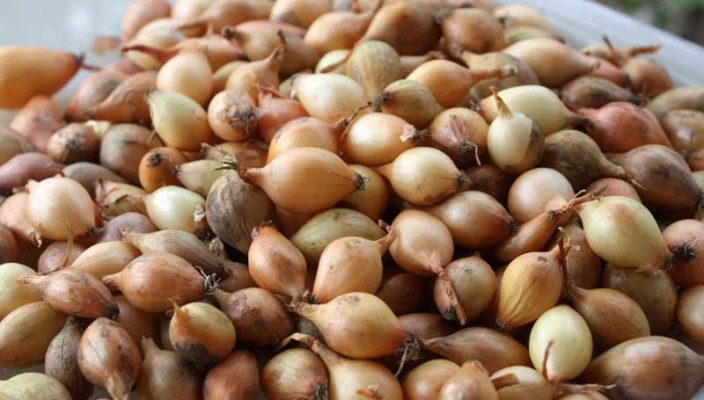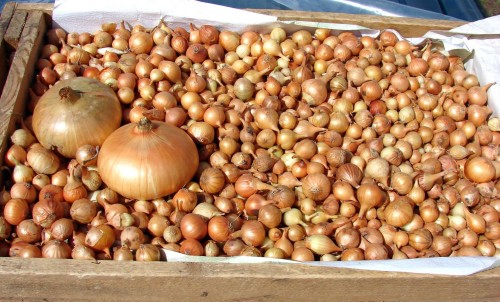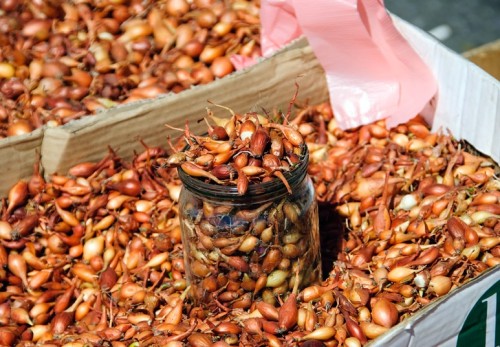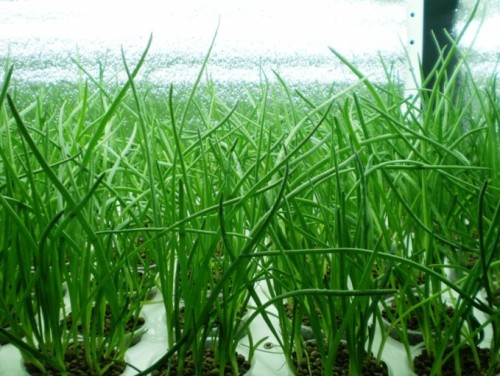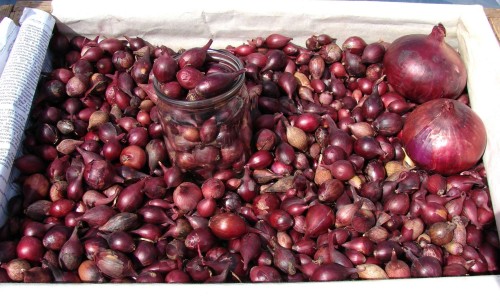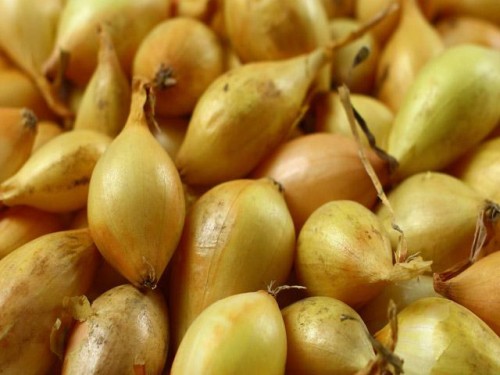Small bulbs, which appear in the first year after planting seeds, are called onions of the navigation. Some of them later, you can subsequently grow large onions suitable for eating. And the crop of culture will directly depend on how the sewn was assembled and under what conditions he was saved. About how to store the onions of the north, you will learn from this article.
Content
Rules for the choice of high-quality onions Sevka
You can prepare the onions of the north of your own material, and you can purchase in the store. Regardless of how the option you give preference, the sevka should be suitable for the choice. So, what to take into account when the billet onion, the sevka for landing:
- It is logical to assume that the first thing you need to pay attention to the variety and its taste characteristics.
- It is also worth taking into account the endurance of the bow, its resistance to high humidity and low temperatures, since the growth activity of culture directly depends on these indicators.
- The planting material should have a characteristic onion smell without impurities of smells of rot and mold. Only healthy and intact bulbs are suitable for landing.
- After drying, the bow of the navigation should make a rustling sound - this indicates good quality material.
- Form, size and color of the bulbs must correspond to the parameters of the selected variety of culture.
- An important criterion is also the appearance of culture. High-quality sowing material has an attractive view, a flat brilliant surface, there are no damage, mold, rot, traces from insects. The color of good sevark is uniform, beautiful, without spots.
- Before landing, it is important to check that the whole onion was well succeeded. If wet instances are found in the total mass, they will definitely be dried.
- When buying onions, the sevka in the store or on the market, you need to clarify the seller the name of the variety, the maximum storage period, the conditions under which the planting material should be saved. Sailor, bleeding, the amount of crop and the size of the collected fruits depend on the variety of culture.
When choosing onion, Sevka should also pay attention to its size. Depending on this parameter, several varieties of culture distinguish:
- Non-Savka varieties are distinguished by a small size reaching 10-15 mm in diameter. Such cultures are most often planted late in autumn.
- Mediterranean varieties are characterized by several large sizes. Bulbs of such sevka reach 15-22 mm in diameter.
- Multi-bend Luke varieties are considered the largest, such north grows up to 23-40 mm in diameter.
Mediterranean and middle-tract varieties are made in the spring, and until the place of landing, the material is stored all winter in suitable conditions. From the largest specimens in winter and spring can also be grown green onions.
The onions of the navigation, depending on the size, also divide on various fractions:
- The onion shallow fraction consists of instances, the size of which does not exceed 14 mm. Such material is best planted for the winter, but in the spring landings, small-scale segues are not used. Given that small bulbs very often freeze, you need to plant them in large quantities. In addition, the harvest of such a culture matures almost a month later than the urgent and large-scale bows. The small-scale segue does not produce green arrows, and it is better to plant it in the nutritional soil, because in the absence of useful substances in the bulk, the bow will be small.
- The onion of the middle fraction is represented by copies of up to 21 mm. Such a culture is often planted late in the fall, but also for the spring planting such a plant is also suitable. As in the previous case, the north of such a fraction of green stems does not release.
- The bow of a large fraction reaches in the size of 24 mm, it is planted in the ground in the late autumn. Since such a plant gives a large amount of greenery, most often it is used precisely for similar purposes. The north of the big faction is recommended to disembark those who are just begins to try themselves as a gardener, since such a culture will give a harvest in almost 100% of cases.
- The large-scale onion consists of instances of 30 mm in size, the culture is planted mainly under the winter in order to obtain green feathers.
- The north of a very large fraction is a bulWhi of up to 40 mm. They are also sitting mainly in order to grow green stems. The shooter does not release such a fraction, but only if you follow the right storage conditions. Experienced gardeners advise to warm up such north before landing it into the ground.
It is worth saying that the bow larger fractions is rarely used for germination, since it is inclined to release the shooter. In addition, if you decide to grow onions of the north, it is desirable to use only one fraction, and there are several reasons for that:
- the material of one size is easier to prepare for landing;
- vintage from landing Sevka one fraction will be greater than at least by 20%;
- having planted a single-aligned bow, you will be exactly sure that it matures about at one time;
- the size of most copies after obtaining the crop will be approximately the same.
It is impossible not to note that growing onions of the north is much easier and more profitable than cultivating the plant with seeds, and there are certain reasons for it:
- the bow of the north gives yields much earlier than the seeds of culture;
- since the plant grown from small bulbs is developing much faster, ready-made fruits are obtained larger;
- one of the peculiarities of cultivation is the development of a powerful and strong root system, the plants are stronger and can receive a sufficient amount of moisture even from dry soil;
- luka Sevka is not as terrible weeds, which are taken from the soil nutrients necessary for the growth of culture;
- if you plan the seeds into light soil, the likelihood of the loss of part of the crop due to wind erosion is great. With the bow of the navigation, such a thing cannot happen;
- sevov is much better than seeds, transfers mechanical processing before planting in the ground.
Ruke Rules Sevka
Before removing the bow to storage, it needs to be collected. Already at this stage of the preparation of the planting material, there are some rules and recommendations:
- Watering cultures should be discontinued about a month before the collection.
- It is possible to remove the segue for storage when the leaves on the plant began to turn yellow and faded, and the bulWhi in the ground was growing to the desired size.
- It is also important to pay attention to the weather. In the dry and warm summer of the north, they are collected in about august in August, but if the season was raw and rainy, it is possible to start cleaning in the recent days of July. The rains can provoke the re-germination of Sevka and if tightening culture with cleaning, it will be stored much worse. With sufficiently formed bulbs you can start work, without waiting for the fiction of the leaves.
How to keep the bow of the navigation
Selection of places and features of Luke Storage
So that the onions of the north did not sprode before the deadline, it needs to be saved in a dark, cool enough and necessarily a dry room. However, the temperature of the air should not be too cold, otherwise the culture simply freezes and loses its germination. Those who live in a private house are conveniently stored in the basement or in the cellar, provided that there is sufficiently dry, and the ambient temperature is maintained at 0 ° C.
Luke storage depends on many factors, consider them in more detail:
- The first factor of long-term storage is considered correctly selected. The bow of the north has a lot of varieties, some of which simply is not stored for a long time.
- If we consider the arrangements of the bow from the point of view of the duration of their storage, then it can be noted that the red and white species germinate much faster, but the varieties of yellow color can lie quite a long time.
- The period of culture harvesting also plays an important role. If the planting material is not assembled on time, it will start germinate and simply will not be able to go all winter.
Preparation of Sevka to winter storage
We ask how to keep the onions of the Sevkov, attention should be paid to the proper preparation of the planting material. So that the culture without any problems flew to spring, you need to fulfill some requirements:
- First you need to choose high-quality landing material. For this, the onions carefully come through, leaving only solid, beautiful and healthy fruits having a smooth intact surface, smooth color, sufficient density. The smell of Luke Sevka should not give to rot or mold.
- Watching the bow is preferably in dry and sunny weather if the process occurs in the open sky. In addition, it follows the boarding material with a special addiction, because if at least one fired instance falls into the bowl container, it is fraught with the damage of the other bulbs.
- The roots of Sevka, retractable for storage, should be dry, there should not be fresh processes.
- Removing the bow for the winter, it should be clearly considered the whole earth.
- The prerequisite for long-term storage of Luke Sevka is its high-quality dryer. To dry the planting material, it must be placed in a well-ventilated warm room with low humidity. The temperature in such a room should be maintained at 25-30 ° C. Under similar conditions, the onions should dry no more than 7 days. After that, the plant is warming up, withsting the seaws at a temperature of 45 ° C for 12 hours. At the end of the drying, the bow will have a light, thin and golden husk, eating a rustling sound when touched.
- You can dry the bow on the old manner. To do this, it is glued to the braid and hang somewhere in a warm place, for example, above the stove. Large bulbs can be eaten, just cutting the right heads from the braids.
- Another way to dry Sevka implies the placement of the lukovych in the female heading stocking. Such a stocking is also placed in the most dry and warm place of an apartment or at home.
You can also store the onions of the north on the appropriate package, for example, in baskets, bags, boxes or drawers. The main thing is that air penetrates freely in the container. It is advisable to put the seaws to the container with a layer not exceeding 25 cm. In addition, during the winter head, it should be periodically verified if some of them are prohibited or moldy, you need to immediately remove similar specimens from the total mass. Onions whose husk just became wet, we need to send again to dry.
Luke Platters Sevka
Owner's storage methods There are several and you need to choose that method to implement that will be easier. Consider these methods in more detail:
- The warm storage of Luca involves holding the planting material at room temperature throughout the winter. The room where the north is saved must be provided with good ventilation, and the temperature in it should be maintained at 18-25 ° C. It is very important that the humidity of the air in the room was low, otherwise the north will start germinate. The temperature is to maintain in a strictly specified range, because if it is colder in the room, the bow will release the arrows, and if the air is the warmer of the upper limit, the head is simply dried and become unsuitable for landing.
- Cold storage method involves cutting onion at temperatures from -1 ° C to -3 ° C. In a private house, such conditions are easy to provide with the help of a unheated basement, the apartment is easier to save onions in the refrigerator. An important condition for such storage, as in the previous case, is low air humidity. Before putting the onions of the navod on cold storage, it is heated for 2 weeks at a temperature of 30-35 ° C. When spring comes and before the expected landing date, approximately 10 days will remain, the seaws need to warm up at the same temperature. After such procedure, the material will be ready for landing into the soil. By the way, you can leave the bow on the cold storage not only in the house, but also on the street. To do this, take a plastic bucket, pour into it a layer of sawdust or ordinary paper, and on top lay out the sucked onions of the north. The planting material is covered by another layer of sawdust, then closed the bucket with a lid and put it in a pre-dug pit. The pocket depth should be about 20 cm more than the height of the bucket, and it should be digging it on a relatively dry plot of the Earth or on a small hilly. A bucket, immersed in the pit, bury and pour out a hill ground. By the spring, such a bow will be suitable for landing.
- There is another way of storing onion Sevka - combined. It combines two previous methods. Initially, the north are placed on warm storage until winter cold come. After that, the temperature at which the onions is saved is gradually reduced until it reaches -1 ° C. In such conditions, the landing material is kept throughout the winter, and when spring comes, the temperature is gradually increased again until it reaches 25-30 ° C. After 3-4 days, this indicator is reduced to 20 ° C and stored in such conditions until it is time to plant it into the ground.
Onions of the north, photo:

